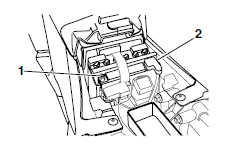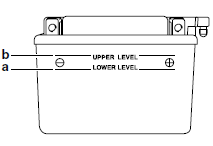Yamaha YZF-R125 Service Manual: Checking and charging the battery
| WARNING Batteries generate explosive hydrogen gas and contain electrolyte which is made of poisonous and highly caustic sulfuric acid. Therefore, always follow these preventive measures:
FIRST AID IN CASE OF BODILY CONTACT: EXTERNAL
INTERNAL
|
1. Remove:
- Rider seat Refer to "GENERAL CHASSIS" on page 4-1.
2. Disconnect:
- Battery leads (from the battery terminals)
| CAUTION: First, disconnect the negative battery lead "1", then the positive battery lead "2". |

3. Remove:
- Battery
4. Check:
- Electrolyte level
The electrolyte level should be between the
minimum level mark "a" and the maximum
level mark "b".
Below the minimum level mark
 Add
Add
distilled water to the proper level.
| CAUTION: Add only distilled water. Tap water contains
minerals which are harmful to the battery. |
5. Check:
- Specific gravity
Less than 1.280
 Recharge the
Recharge the
battery.
6. Charge:
- Battery
Battery charging amperage and time 5.5 amps/10 hrs
WARNING
Do not quick charge a battery.
CAUTION:
|
NOTE:
- Replace the battery whenever:
- battery voltage does not rise to specification or bubbles fail to rise during charging,
- sulphation of one or more battery cells occurs (as indicated by the battery plates turning white or material accumulating in the bottom of the battery cell),
- specific gravity readings after a long, slow charge indicate that one battery cell's charge is lower than the rest,
- warpage or buckling of the battery plates or insulators is evident.
7. Check:
Battery breather hose and battery vent Obstruction → Clean.
Damage → Replace.
8. Install:
- Battery
9. Connect:
- Battery breather hose "1"

CAUTION:
|
10.Check:
- Battery terminals
Dirt → Clean with a wire brush.
Loose connection → Connect properly.
11.Connect:
- Battery leads (to the battery terminals)
| CAUTION: First, connect the positive battery lead "1", then the negative battery lead "2". |

12.Lubricate:
- Battery terminals

13.Install:
- Rider seat Refer to "GENERAL CHASSIS" on page 4-1.
 Checking the fuses
Checking the fuses
The following procedure applies to all of the fuses.
CAUTION:To avoid a short circuit, always turn the
main
switch to "OFF" when checking or replacing
a fuse.
1. Remove:
Ri ...
 Checking the relays
Checking the relays
Check each switch for continuity with the pocket
tester. If the continuity reading is incorrect, replace
the relay.
1. Disconnect the relay from the wire harness.
2. Connect the pocket tester ( ...
Other materials:
Setting the normal mode
NOTE:
The engine speed, coolant temperature, and fault code, if detected, can be
displayed on the LCD of the
FI diagnostic tool when the tool is connected to the vehicle and is set to the
normal mode.
1. Set the main switch to "OFF" and the engine stop switch to "".
2. Disconnect the self- ...
Removing the starter clutch
1. Remove:
Starter clutch bolts "1"
NOTE:
While holding the generator rotor "2" with the
sheave holder "3", remove the starter clutch
bolts.
Do not allow the sheave holder to touch the
projection on the generator rotor.
...
Checking the ignition spark gap
1. Check:
Ignition spark gap
Out of specification Perform the
ignition
system troubleshooting, starting with step 5.
Refer to "TROUBLESHOOTING" on page
8-3.
NOTE:
If the ignition spark gap is within specification,
the ignition system circuit is operating normally.
a. Disconnect the spa ...

